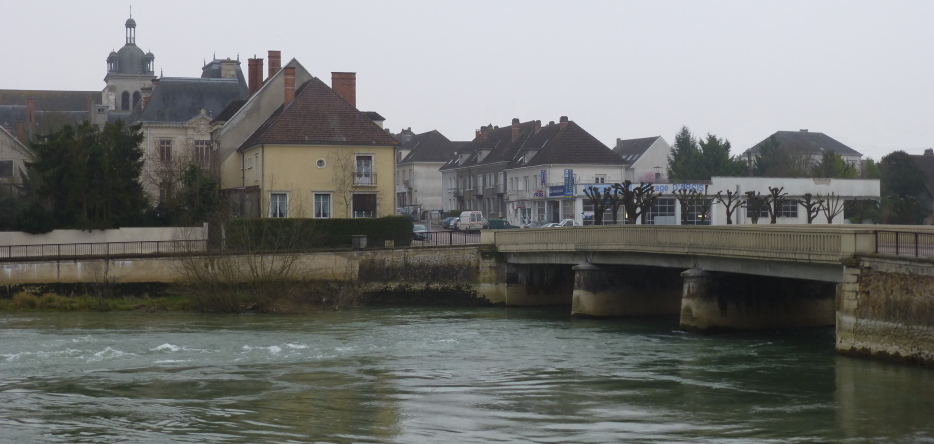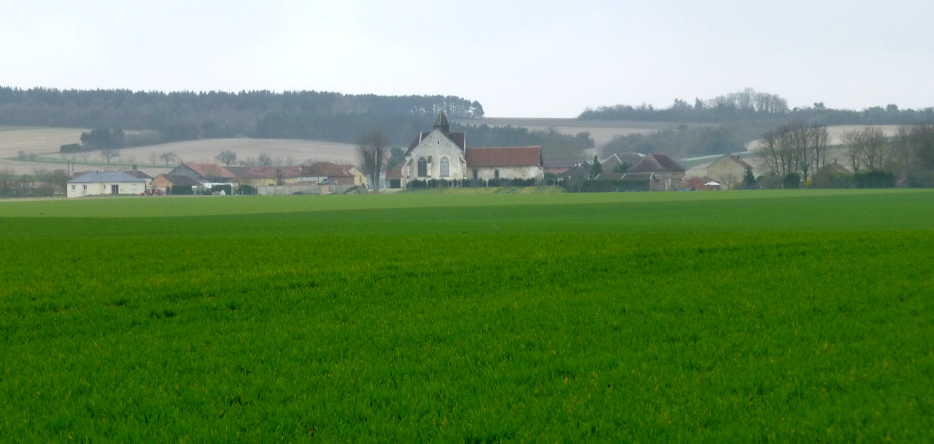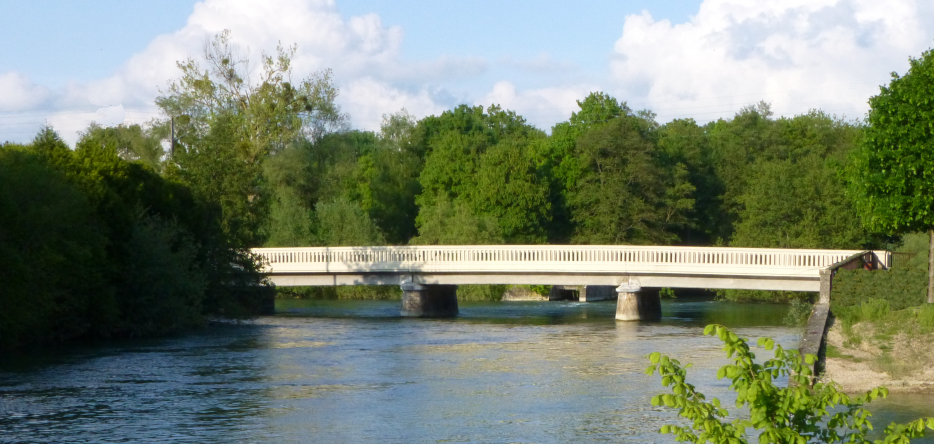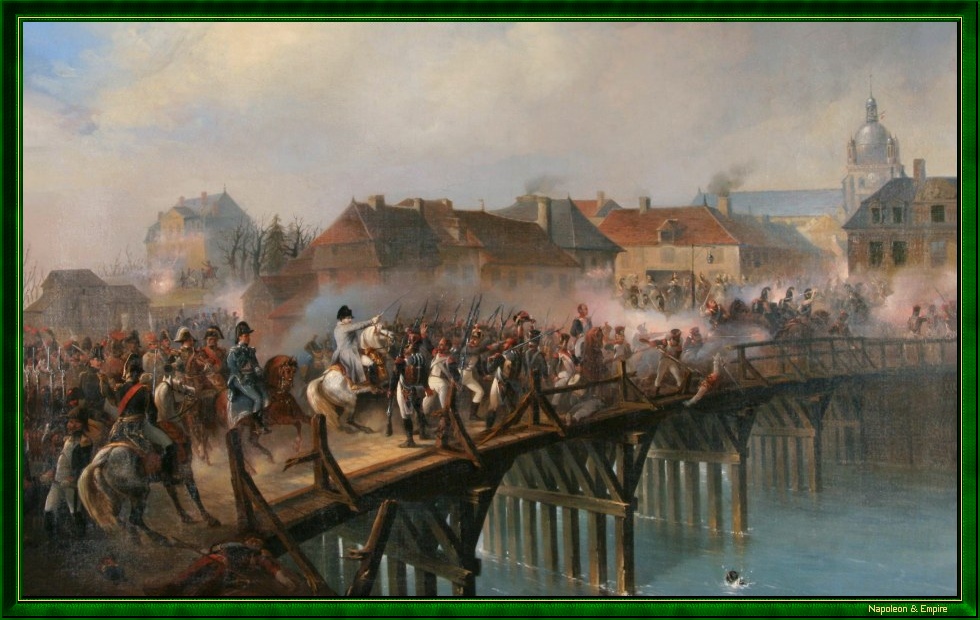Date and place
- March 20th, 1814 at Arcis-sur-Aube, Champagne, France (nowadays Aube department, Grand-Est region).
Involved forces
- French army (20,000 then 28,000 men) under Emperor Napoleon I.
- Austrian army (480 to 100,000 men, not all of whom will be engaged) under Prince Karl Philipp zu Schwarzenberg.
Casualties and losses
- French Army: 1,700 killed, injured or missing, 800 prisoners, 3 cannons.
- Allied Army: around 4,000 men killed, injured or lost.
Aerial panoramas of Arcis-sur-Aube battlefield
After his series of victories over the Army of Silesia, Napoleon turned against the Austrian army. His goal was still to prevent the two enemy armies from joining and thus protect Paris from a joint attack. He was to suffer a failure, the disproportion of forces being this time insurmountable.
General situation and Napoleon's plan of action
After the battle of Reims on March 13, 1814, Napoleon gave his troops three days' rest, and then set out to follow in the footsteps of Prince Karl Philipp zu Schwarzenberg. Since the French had retaken Reims , Soissons and Châlons, the Allied generalissimo had had to extend his right to maintain communications with Gebhard Leberecht von Blücher, who had been pushed back to Laon by operations in early March.
As a result, the front of the large Allied army was excessively spread out, giving rise to the hope of either confronting it in fractions or forcing it to regroup, which it could hardly do without retreating as far as Bar-sur-Aube .
In either case, the Emperor felt that Blücher, isolated, would no longer be able to march on Paris, or else, doing so alone, would be unable to take it. Moreover, in these circumstances, i.e. outside the presence of the allied sovereigns, it was likely that even the fall of the capital would not bring about the fall of the regime.
Napoleon therefore left Marshals Edouard Mortier and Auguste Viesse de Marmont on the river Aisne with almost 20,000 men to cover Paris and conceal his own movement.
He took with him only 10,000 infantrymen and 6,000 cavalrymen, counting on a reinforcement of 6,000 men to be brought to him by General Charles Lefebvre-Desnouettes, and above all on Marshal Etienne Macdonald's corps, with which the junction was planned for the 20th on the river Aube. Together, they would make up an army of 55,000 soldiers, including nearly 17,000 cavalry.

Preliminary movements and position before the battle
The Emperor set off on March 17. He passed through Epernay , Avize, Vertus , La Fère-Champenoise and reached Plancy-l'Abbaye [48.56953, 3.96616] on the 19th, intending to attack the enemy from the flank as he marched between the Aube and the Seine, since he had expressed his intention to regroup around Troyes .
Faced with this movement, the interpretation of which posed difficulties for him, Schwarzenberg was extremely irresolute. As a result, his own maneuvers became somewhat erratic, and it was only on the evening of the 19th, on learning that Napoleon had occupied Plancy and Méry-sur-Seine [48.50773, 3.89025] without having attacked Arcis [48.53669, 4.14188], that he deduced that Napoleon's objective was Troyes and not Brienne , as he had believed on several occasions during the last few days.
At this point, the positions were as follows:
- Napoleon was at Plancy with the service squadrons, the Friant division bivouacked on either side of the Aube;
- Marshal Michel Ney's infantry was a little behind the village, his cavalry at Viâpres;
- The rest of the army is still a long way off. Marshal Macdonald on the Villenoxe side with his cavalry; his infantry between Provins and himself; a few detachments at Sézanne and La Ferté-Gaucher; the Michel-Marie Pacthod 's division at Bray, Nogent and Pont-sur-Seine.
On the Allied side:
- General Nikolay Nikolayevich Raevsky (Николай Николаевич Раевский) was in front of Troyes, at Pont-Sainte-Marie, where Ignácz Gyulay and Prince Wilhelm Friedrich Karl von Württemberg would join him during the night;
- Carl Philipp von Wrede was in the vicinity of Nogent-sur-Aube;
- The guards and reserve were a little north of Brienne, towards Perthes-les-Brienne.
With most of his army around him, Schwarzenberg decided to attack. His plan was to assemble his forces in front of Plancy and drive the French back either to the north bank of the Aube or to the south bank of the Seine, depending on their position at the time of the engagement. The orders he issued were all based on this conception.
Raevsky and Giulay were to place themselves under Württemberg's orders and move together in columns to the height of Charmont by nine o'clock the following day. They were then instructed to head for Plancy, for the infantry, and, for the cavalry, to cover the left of the position as far as Méry.
Wrede's columns are expected at the same time at Chaudrey (to the east), his cavalry liaising with Württemberg. Their particular mission is to follow the river Aube, pass Arcis and seize the Barbuise Brook defile.
Finally, it was planned that the guards and reserve, having crossed the Aube in Lesmont , would by this time have reached their positions around Auzon and in front of Mesnil-Lettre. The attack was scheduled for eleven o'clock.
The fighting on March 20
Around ten o'clock on the morning of the 20th, Napoleon ordered Marshal Ney and General Horace Sébastiani to occupy Arcis.

Inhabitants having informed them of the approach of an allied army, the French forces moved into position to defend the village:
- Jean Guillaume Janssens 's division controlled the Brienne road at [Torcy-le-Grand] ;
- Sébastiani's cavalrymen controlled the Troyes road;
- Jean-Marie Antoine Defrance 's division advanced towards Vinets in the direction of Ramerupt;
- Louis Friant 's and Louis-Michel Letort de Lorville 's divisions were also called to Arcis, but due to a misunderstanding, the latter brought only his dragoons.
At around 1 p.m., the Emperor himself went to Arcis and had the enemy's position reconnoitred. On the basis of a report that indicated only a few Cossack parties, he decided to wait on the spot for the rest of his troops, chief among them Macdonald's corps, which he expected to arrive during the day.
For their part, the allies were behind schedule, having had to rest some of their troops, exhausted by the marches. It was only around one o'clock that Schwarzenberg, seeing that the French were already occupying Arcis-sur-Aube, gave the signal to attack the village, which he wanted to seize and then march on to Plancy. Wrede was then deployed from Vinets (on the right bank of the Aube) to the road to Troyes, and it was he who struck the first blow.
They fell first on Sebastiani's cavalrymen, who were too isolated on the road to Troyes. Lacking support, charged by an enemy outnumbered and bombarded, they were pushed back to Arcis in disarray. Napoleon himself, sword in hand, had to throw himself in front of the fugitives to stop the stampede. The arrival of the Friant division restored the situation.
At the same time, Wrede attacked Grand-Torcy and drove the French out, only to be driven back himself. He never succeeded in retaking it, despite sustained efforts to do so.
In the center, Württemberg advanced towards Plancy unopposed until around four o'clock in the afternoon, in the vicinity of Rhèges. He then cut off the route of the forgotten Letort division, which was on its way to Arcis to rejoin its leader. Attacked head-on and on both wings, this elite troop of grenadiers and chasseurs of the Guard defended valiantly and, with the timely help of a few artillery reinforcements, managed to fall back to Méry.
Meanwhile, fighting continued in front of Arcis. At six o'clock in the evening, Schwarzenberg made a last effort to seize Torcy. A corps of Russian grenadiers, a cuirassier division and the Prussian horse guard were thrown into the fray, supported by seventy cannons.
On the other side, the defenders, reinforced by the Friant division and two battalions of gendarmes, held firm, despite the loss of their leader, general Jan-Guillaume Janssens, who was seriously wounded.
The battle went on until 11 p.m., in the glow of the flames that consumed Arcis, burnt by the bombardment of the coalised. Finally, the allies tired and abandoned the battlefield.
On the road to Troyes, Sébastiani, having regained his position, had been fighting all day with varying degrees of success when, at nightfall, he received reinforcements from general Lefebvre-Desnouettes' division. He took advantage of this to launch a new attack at around 9 p.m., which narrowly failed to break Wrede's left wing. Wrede was able to contain the charge, however, and Sebastiani resumed his position on the right (west) of Arcis, without the enemy pursuing him.
Finally, on the Allied far right, on the right bank of the Aube, the Defrance division pushed back its attackers as far as Ramerupt. It did not stop until the Allied command, worried about Brienne, sent an additional division to the area.
At the end of the day, the French army remained in control of the battlefield. It bivouacked there.
Arrangements taken during the night of March 20 to 21
During the night, Schwarzenberg read reports estimating the Emperor's forces at seventy thousand men, and became convinced that Napoleon would intend to attack him in open country the following day. He chose to accept the battle and redeployed his army on this assumption.
On the 21st, the coalition troops occupied the following positions:
- On the right bank of the Aube, a light-guard division stood towards Ramerupt, forming the extreme right of the position;
- Wrede's corps formed the right, between Ortillon and Mesnil-la-Comtesse;
- Then came the Württemberg and Giulay corps, then, organized in echelons, the cavalry of these two corps joined with that of the Raevsky corps, which extended the line to the rear of Nozay ;
- The Cossacks held the extreme left, bordering the west of the Barbuise brook, from Nozay to Pouans;
- The guards, several grenadier and cuirassier divisions held the position occupied the day before by the reserve north of Brienne.

The Prince of Schwarzenberg completed his preparations by bringing seventy-two cannons into line.
Napoleon, for his part, believed he could deduce from the few forces thrown into the battle on the 20th by the coalition forces that the fighting had only served to mask their retreat. As various reports during the night reinforced this idea, he made arrangements for the next day's battle with the small contingent he believed to be facing him at the time.
He recalled several of the divisions that had remained at Plancy, had them cross the Aube at dawn and, at around 8 a.m., when Marshal Nicolas Charles Oudinot arrived with reinforcements, arranged his army in battle:
- Ney was on the left with 13,500 infantrymen;
- Oudinot in the center with 9,000 men;
- Sébastiani on the right with 7,300 cavalrymen,
making a total of less than 30,000 combatants.
Operations on March 21: Napoleon's withdraw
At around ten o'clock, Sébastiani received the order to advance, supported by Ney. They discovered the enemy army, some 110,000 strong and in battle order, waiting for them on the plateau south of Arcis.
Despite the disproportion of forces, Sébastiani engaged the allied cavalry after seizing Moulin-Neuf, on the Barbuise brook, 3 kilometers west of Villette.

Meanwhile, Ney sent word to Napoleon. Napoleon advanced to a high ground from where he could judge for himself how risky his situation was.
With his numerical superiority, Schwarzenberg could easily face him head-on, while at the same time sending Wrede's corps to attack him at Torcy, on his left flank, which was almost bare.
As Marshal Macdonald's corps could not arrive before evening, the Emperor preferred not to risk the elite of his army in a battle that was too unequal, and decided to retreat. The divisions under Ney's command were the first to fall back, while Oudinot's infantry supported the cavalry for a while, who covered the retrograde movement. To facilitate the evacuation of the last soldiers, a bridge was improvised between Ormes and Villette .
Opposite, Schwarzenberg awaited Napoleon's attack, which the appearance of the French column heads on the Arcis plateau seemed to confirm was imminent. The results of the first charges led by Sébastiani worried him, however, as Piotr Petrovich Pahlen (Па́вел Петро́вич Па́лен) 's cavalry was almost knocked off its feet, and it took the intervention of the second echelon to pull it out of this predicament.
Unconfident, he feared being outflanked on both his right and left, and remained motionless for four hours, waiting to see the development of opposing maneuvers before reacting.
By 2 p.m., there was no longer any room for doubt: the French were retreating. Schwarzenberg decided to advance his army. Ever mindful of protecting the Brienne road, he deployed his right wing beyond the Aube, where Wrede settled between Dommartin and Donnement. Two grenadier divisions were left in place at Chaudrey and on the Mesnil-la-Comtesse heights, supported by a small amount of cavalry, while the rest of the guards and reserve were positioned to support Wrede on the river Voire . The Prince of Württemberg, supported by Giulay and Raevsky, was tasked with attacking the troops still covering Arcis and taking the town.
By this time, although Sébastiani was still fighting, Ney had already crossed the Aube. Oudinot was ordered to protect the approaches to Arcis and hold back the enemy as long as possible. The streets were barricaded and sappers were ready to destroy the bridge [48.53830, 4.14201].

Württemberg's infantry presented themselves in columns in front of the city, while the bulk of the cavalry threw themselves at Sébastiani's cavalry. Sébastiani then began a chessboard retreat and managed to cross the Villette bridge in good order.
Meanwhile, Arcis came under such heavy cannon fire that Marshal Oudinot, unable to resist the attack of forty thousand men, also ordered his soldiers to withdraw. Crossing the bridge was not without difficulty, as the enemy managed to establish themselves for a time in the Méry suburb.
Finally, the evacuation of the town was more or less orderly, and the Duke of Reggio (Oudinot) was able to take up position on the right bank of the Aube, at the hamlet of Les Vasseurs (at the junction of the Châlons road and the road from Ormes to Les Chênes), while the sappers proceeded behind him to destroy the bridge, under the protection of one of his brigades.
At nine o'clock in the evening, Marshal Macdonald arrived. Part of his troops and General François-Etienne Kellermann's cavalry moved to Ormes, where Sébastiani was already stationed. The rest took up position at Viapre-le-Petit, a little further west. Napoleon, for his part, was already in Sompuis .
The allies took up positions in Arcis, Donnement, Dommartin, Ramerupt, Luistre and Vinets.
Results and consequences
These two days cost the French 2,500 men and three cannons, and the Allies probably 4,000 soldiers. The balance sheet was therefore not catastrophic, and it was less the loss of the engagement itself than the general failure of Napoleon's operational plan, of which the battle was more the effect than the cause, that was fraught with consequences.
Napoleon's attack on Schwarzenberg achieved neither of the two results he had hoped for: defeating him in detail or pushing him back to Bar-sur-Aube.
To achieve the same result in another way, Napoleon decided to operate on the enemy's lines of communication, cutting them off from their bases and depriving them of their ammunition. So, without missing a beat, he took the road to Vitry and Saint-Dizier. How could the Allies let him do this without giving chase, and thus distance themselves from Paris?
Map of the battle of Arcis-sur-Aube

Picture - "Napoleon at Arcis-sur-Aube". Painted by Jean-Adolphe Beaucé.

Marshal Oudinot received the thirty-second and final wound of his glorious career at this battle: a bullet hit him in the chest, but crashed into his Légion d'Honneur Grand Eagle plaque!!
 Display the map of the Campaign in northeast France in 1814
Display the map of the Campaign in northeast France in 1814
Photos Credits
Photos by Lionel A. Bouchon.Photos by Marie-Albe Grau.
Photos by Floriane Grau.
Photos by Michèle Grau-Ghelardi.
Photos by Didier Grau.
Photos made by people outside the Napoleon & Empire association.